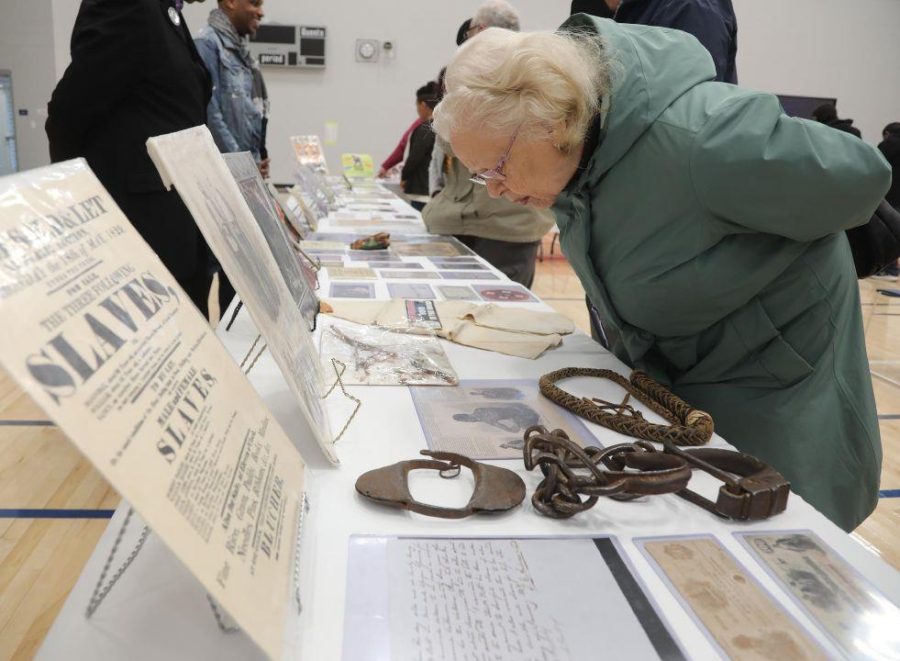Black History 101 Mobile Museum Exhibit Comes to Oberlin Elementary School
As part of a national tour, the Black History 101 Mobile Museum was on display at the Oberlin Elementary School gymnasium March 6 and 7. The exhibit includes, per the museum website, “non-traditional museum spaces such as classrooms, conference rooms, libraries, galleries, and even living rooms.”
The exhibit featured approximately 300 artifacts. The mobile museum is part of a project founded by Dr. Khalid el-Hakim, who has collected more than 10,000 artifacts commemorating Black history in the U.S. The collection in its entirety represents a variety of categories, ranging from the trans-Atlantic slave trade to recent moments in Black pop culture.
“Shackles, a whip, and cotton were on display as part of the Black History 101 Mobile Museum inside the Oberlin Elementary School gymnasium,” Marketing and Communications Consultant for Oberlin City Schools Melissa Linebrink wrote in a press release.
In addition to the three-dimensional artifacts documenting the trans-Atlantic slave trade, the collection also included personal letters and public documents, including a wanted poster that had been posted in search of escaped enslaved people. el-Hakim was present at the exhibit earlier this week and spoke to visitors about the meaning behind some of the displayed memorabilia. As part of the school district’s Comprehensive Literacy State Development Grant, all OES students received a free copy of el-Hakim’s book, Khalid and Khalilah’s ABCs of Black History. Also present was Oberlin community member and retired Oberlin City Schools orchestra teacher Harriett Thomas.
“Each year, the school adopts a book to give to each of the students, and so this book, The ABCs of Black History, will be distributed to all of our students,” Thomas said. “As a matter of fact, all the elementary students will be receiving this book [Mar.3].”
Thomas worked to organize the event and allocated a portion of the Lorain County Community Foundation JB Thomas Fund, for which she is the fund advisor, toward its actualization.
“I was made aware of the museum in August 2022,” Thomas told the Review. “After I read about it, I thought this would be
a really good project that would benefit our students in the Oberlin schools and the community. I contacted Mr. Khalid el-Hakim
and we began to work on bringing the museum to Oberlin.”
According to Development Officer of the Community Foundation of Lorain County Laura Malone, Thomas reached out to the Community Foundation to facilitate the fund’s allocation.
“Harriett spoke with us, but also spoke with the Oberlin School District to help collaborate with us in having this project come to Oberlin,” Malone said. “The Black History 101 Mobile Museum is not its own nonprofit tax-exempt entity, so we needed the collaboration of the Oberlin School District to be able to transfer those funds from the donor-advised fund to the school district and have the school district pay for the cost of having the Black History 101 Mobile Museum here for this visit.”
Prior to the event, Thomas described the display setup.
“The items are all gonna be displayed at the Oberlin Elementary School, and we’re gonna have 12 tables that will be set up in the form of a U-shape,” Thomas said.
“The students will have the opportunity to pass through the museum and view all the artifacts. Everything will be in the new Oberlin Elementary School gymnasium and they’ll be able to come through and view the items there.”
During the day on Monday, the exhibition was shown exclusively to OES students, but in the evening, it became open to the broader public. Langston Middle School students were invited to view the collection Tuesday morning, and Oberlin High School students viewed it later that afternoon. The museum display occurred just after the end of Black History Month and, according to Thomas, served as an appropriate concluding event to OCS’s month of commemorative events.
“This is pretty much the culmination of our Black history projects this year,” Thomas said. “We also have talking posters, which are available at the schools. The students have been able to view these talking posters which were purchased for each of the schools as a set of 12, and they’re 12 famous people in Black history. You download an app and then you can point the app at the picture, and then it comes up on your phone … and it talks and gives you the history. That’s something that our students have really been excited about. We have another project [that] we did at Langston Middle School and Oberlin High School, the Locker Door Decorating Contest, and we just finished picking the winners for that.”











